A plant is
something most people rarely, if ever, think about, but, like animals, and seen with the eyes of faith, even
the lowliest plant invites wonder.
Looked at thoughtfully, plants are transformed into objects of
meditation, symbols and signs of our ultimate end. From their
complexity and beauty, to their gratitude-inspiring usefulness as food
and medicine, they orient us toward the transcendent if we're mindful
enough. So stop and look at the natural
world around
you, taking it all in and following the lead of St. Basil the Great,
who wrote in his fifth homily of "On the
Haexemeron":
I want creation
to penetrate you with so much admiration that everywhere, wherever you
may be, the least plant may bring to yon the clear remembrance of the
Creator. If you see the grass of the fields, think of human nature, and
remember the comparison of the wise Isaiah. "All flesh is grass, and
all the goodliness thereof is as the flower of the field." Truly the
rapid flow of life, the short gratification and pleasure that an
instant of happiness gives a man, all wonderfully suit the comparison
of the prophet. To-day he is vigorous in body, fattened by luxury, and
in the prime of life, with complexion fair like the flowers, strong and
powerful and of irresistible energy; tomorrow and he will be an object
of pity, withered by age or exhausted by sickness...
..."Let the earth bring forth the fruit tree yielding fruit."
Immediately the tops of the mountains were covered with foliage:
paradises were artfully laid out, and an infinitude of plants
embellished the banks of the rivers. Some were for the adornment of
man's table; some to nourish animals with their fruits and their
leaves; some to provide medicinal help by giving us their sap, their
juice, their chips, their bark or their fruit. In a word, the
experience of ages, profiting from every chance, has not been able to
discover anything useful, which the penetrating foresight of the
Creator did not first perceive and call into existence. Therefore, when
you see the trees in our gardens, or those of the forest, those which
love the water or the land, those which bear flowers, or those which do
not flower, I should like to see you recognising grandeur even in small
objects, adding incessantly to your admiration of, and redoubling your
love for the Creator. Ask yourself why He has made some trees evergreen
and others deciduous; why, among the first, some lose their leaves, and
others always keep them. Thus the olive and the pine shed their leaves,
although they renew them insensibly and never appear to be despoiled of
their verdure. The palm tree, on the contrary, from its birth to its
death, is always adorned with the same foliage. Think again of the
double life of the tamarisk; it is an aquatic plant, and yet it covers
the desert. Thus, Jeremiah compares it to the worst of characters --
the double character.
"Let the earth bring forth." This short command was in a moment a vast
nature, an elaborate system. Swifter than thought it produced the
countless qualities of plants. It is this command which, still at this
day, is imposed on the earth, and in the course of each year displays
all the strength of its power to produce herbs, seeds and trees. Like
tops, which after the first impulse, continue their evolutions, turning
upon themselves when once fixed in their centre; thus nature, receiving
the impulse of this first command, follows without interruption the
course of ages, until the consummation of all things. Let us all hasten
to attain to it, full of fruit and of good works; and thus, planted in
the house of the Lord we shall flourish in the court of our God, in our
Lord Jesus Christ, to whom be glory and power for ever and ever. Amen.
A Mary Garden is the perfect thing to make in order to help you think
of
plants in this way.
What is a "Mary
Garden"?
A Mary Garden is
a garden filled with plants, flowers and trees named for Our Lady and
Jesus. They are designed to be places of beauty that remind us of our
Lord and Lady, allowing us to experience God's creation, and inviting
prayer
and contemplation. Because Mary is a type of the Church as Bride, the
garden should be enclosed if at all possible, based on the words in the
fourth chapter of Solomon's Canticle of Canticles:
My sister, my
spouse, is a garden enclosed, a garden enclosed, a fountain sealed
up.
St. Benedict had
a rose garden ("rosary") at his monastery in the 4th c., but the first
garden we know of that was specifically dedicated to Mary was one
created by the Irish St. Fiacre in the 7th c. The earliest record of a
garden explicitly called a "Mary Garden" involves a "fifteenth century
monastic accounting record of the purchase of plants "for S. Mary's
garden" by the sacristan of Norwich Priory, in England." 1
Before the rise of Christendom, many flowers were associated with pagan
deities -- Diana, Juno, Venus, etc. -- but when the "Age of Faith"
ascended and superceded the pagan, these flowers were
"christened" and re-dedicated to Christian themes. So many flowers were
named for Jesus, Mary, the angels, holy places, etc. -- enough such
that you can create a garden focused on specific aspects of Mary and
Jesus' lives, such as His Passion or her sorrows. Enchanting names,
like "Our Lady's Tears" (spiderwort), "Christ's-Cross Flower" (Summer
phlox), "Joseph's Coat" (Amaranthus), "Pentecost Rose" or "Mary's Rose"
(peony), and "Our Lady's Mantle" (Morning Glory), abounded. Sadly,
during the Protestant rebellion and the rise of secularism, many of
these flowers were re-named yet again with more wordly names but, of
course, these flowers still exist and to many Catholic gardeners, their
religious names are still meaningful.
The dedication booklet for Pennsylvania's St. Elizabeth Ann
Seton Parish's Mary
Garden includes the following, which will give you an idea
about how Mary Gardens recall the lives of Mary and Jesus. The booklet
asks the reader to visit the garden and think of Mary:
"Picture her
eyes (Forget-Me-Nots), her hair (Maidenhair Fem), her five fingers
(Potentilla). Think about her apparel: her smock (Morning Glory), her
veil (Baby's Breath), her nightcap (Canterbury Bells), her gloves
(Foxglove), and her shoes (Columbine). Remember her attributes: Mary's
humility (Violet), the fruitful virgin (Strawberry), Mary's queenship
(Virgin Lily), Mary's Flower of God (English Daisy), Mary's glory
(Saint John's Wort), and Our Lady's Faith (Veronica).
Think about her life: The Bethlehem Star (Bellflower), the Christmas
Flower (Poinsettia), Lady's Bedstraw (Dianthus - Mary used bedstraw to
prepare a bed for Jesus), the Epiphany flower (Chrysanthemum), the
Flight into Egypt (Fig Tree - legend says that the Holy Family ate the
fruit of this tree during their flight into Egypt), Our Lady's Tears
(Lily of the Valley - tiny white nodding bell-shaped flowers can be
likened to a train of tears), Our Lady's Tresses (Asparagus Fern -
legend holds that at the foot of the cross, Mary, in. deep agony, tore
out a tress of her hair which Saint John preserved), Mary's Bitter
Sorrow (Dandelion), and the Assumption (Hosta - Plantation Lily blooms
at the time of the Feast of the Assumption)."
You can plant
flowers whose names and form evoke the Fourteen
Stations of the Cross
or the Fifteen Mysteries of the Rosary so
that by walking through your
garden you not only enjoy its natural beauty, but practically "make the
Stations" or "walk the Rosary," turning your backyard , schoolyard, or
churchyard into a holy shrine (especially when accented with beautiful
statuary).
If you don't have lots of room, you can make mini-gardens on your patio
or apartment's balcony, or grow miniature plants in dishes or terraria
for inside your home (nice gifts for the homebound!). If you do have
lots of room, especially if you live in the country, consider setting
up a little roadside shrine and
garden so people passing by can stop and rest at a beautiful sacred
place.
Below is a table of modern common names, scientific names, and
medieval, religious names and meanings of flowers, plants, and shrubs,
along with a few other plants relevant to our Lord's life. Separately
below in the table, you'll find the same for herbs. The month
associated with those flowers deemed as "birth flowers" have the birth
months rendered in (italicized parentheses):
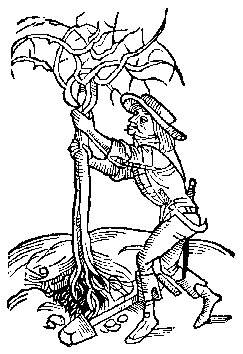
| Common Name |
Scientific
Name |
Medieval Name
and/or Religious Meaning |
| Amaryllis |
Amaryllis
belladonna |
Beautiful Lady |
| Amaryllis |
Hippeastrum
hybr. |
St. Joseph's Lily |
| Anemone,
double-flowered |
Anemone
coronaria |
St. Brigid |
Árbol de San
Pedro (or Hierba de San Pedro)
|
Tecoma stans |
Called Yellow
Elder in English (also yellow bells, yellow trumpetbush, and
Esperanza), its Spanish name means "Tree of St. Peter." |
| Aster |
Aster
nova-belgii |
Michaelmas Daisy
(September) |
| Baby's Breath |
Gypsophila
panicul. |
Lady's Veil |
| Bachelor's
Buttons |
Centauria cyannis |
Mary's Crown |
| Bean caper plant
|
Zygophyllum
dumosum |
? Found on
Shroud of Turin. See footnote for more information on the flowers of
the Holy Shroud. |
| Begonia |
Begonia
fuchsioides |
Heart of Jesus |
| Begonia |
Begonia fuch.
rosea |
Heart of Mary |
| Bellflower |
Adenophera |
Lady Bell |
| Bird of Paradise |
Streliztia
reginae |
Bird of Paradise |
| Black-Eyed Susan
|
Rudbeckia hirta |
Golden Jerusalem |
| Bleeding Heart |
Dicentra
spectabilis |
Mary's Heart |
| Blue Phlox |
Phlox divaricata
|
Lady's Wedding |
| Bluets |
Houstonia
caerul. |
Madonna's Eyes |
| Bougainvillea |
Bougainvillea
gen. |
Trinitaria |
| Buttercup |
Ranunculus acris
|
Lady's Locks |
| Buttercup |
Ranunculus sp. |
Our Lady's Bowl |
| Camelia |
Camellia
(japonica) |
(Purity) |
| Calla Lily |
Zantedeshia
aethiop. |
St. Joseph's
Staff |
| Canna |
Canna generalis |
Rosary Beads |
| Canterbury Bells
|
Campanula medium
|
Our Lady's
Nightcap, Mary Bells, Our Lady's Smock |
| Caper, Caper
bushes |
Capparis spinosa
(var. aegyptia) |
? Found on
Shroud of Turin. See footnote for more information on the flowers of
the Holy Shroud. |
| Carnation |
Dianthus
caryophyllus |
Mary's Love of
God. These flowers are said to have bloomed at Christ's Nativity,
according to a German legend. (January) |
| Castilian roses
(Damascus Roses or Damask Rose) |
Rosa damascena |
I am not sure of
the medieval name for these native-to-Spain flowers, but these are the
variety that St. Juan Diego found after the vision of Our Lady at
Guadalupe. |
| Chrysanthemum
(mum) |
Chrysanthemum |
All Saints'
Flower. Chrysanthemums in general are associated with death and are
used and funerals and to adorn graves (Chrysanthemum coronarium is
believed by scientists to have been present when Christ was laid in the
tomb. See footnotes). (November) |
| Clematis |
Clematis
virginiana |
Virgin's Bower |
| Clematis |
Clematis
(flammula) |
Cross |
| Columbine |
Aquilegua
vulgaris |
Our Lady's
Shoes, Lady's Slipper. Said to have sprung up under Our Lady's feet as
she went to visit Elizabeth. The dove-shaped petals of this flower
invited -- and invites -- its use for decoration on the Feast of the
Pentecost. It is also representative of Our Lady's Sorrows.
|
| Corn Marigold |
Chrysanthemum
segetum |
Mary's Gold (November)
|
| Cosmos |
Cosmos sp. |
St. Michael's
Flower (September) |
| Costmary |
Chrysanthemum
bals. |
Mary's Leaf |
| Cowslip |
Primula veris |
St. Peter's Keys |
| Crocus |
Crocus vernus |
Penitent's Rose |
| Cross Vine |
Bignonia
capreolata |
Cross Vine |
| Crown Daisy |
Chrysanthemum
coronarium |
? I don't know
the medieval name for this flower, but "Crown Daisy" is appropriate:
this flower shows up on the Shroud of Turin. See footnote for more
information on the flowers of the Holy Shroud. |
| Daffodil |
Narcissus
pseudo-narc. |
Mary's Star |
| Dahlia |
Dahlia (hybrids)
|
Churchyard Flower |
| Day Lily |
Hemerocallis
flava |
St. Joseph's Lily |
| Dieffenbachia |
Dieffenbachia
sao ant. |
St. Anthony
Dieffenbachia |
Dog Rose
(general)
|
Rosa canina |
Mary's Thorn
|
| Dog Rose |
Rosa canina
Assisiensis |
This specific
Dog Rose cultivar is named after the dog roses growing in Assisi -- the
rose bushes St. Francis flung himself into in order to subdue his body.
This is the only dog rose that now has no thorns, said to be attributed
to the roses giving up their thorns when they touched the Saint's flesh
|
| Dutchman's
Breeches |
Dicentra
cucullaria |
I don't know the
medieval name for this interesting flower, but it has sentimental
interest for me so I would love to discover it if anyone happens to
know and cares to write. |
| Edelweiss |
Leontopodium
alp. |
Purity |
| Easter Lily |
Lilium
longiflorum |
Easter Lily |
| English Daisy |
Bellis perennis |
Mary-Love |
| English Holly |
Ilex aquifolium |
Burning Bush |
| Evening Primose |
Oenothera
biennia |
Easter Candle |
| Fern |
Asplenium
ruta-mur. |
Lady's Hair |
| Field Bindweed |
Convolvulus
arvensis |
This lovely
flowering plant -- closely related to, resembling, and sometimes called
the same name as the Morning Glory -- is pervasive once planted and,
so, is generally considered a weed. Its old common name according to
the Grimm's short tale of the same name is "Our Lady's Little Glass."
The story in its entirety: "Once upon a time a waggoner's cart which
was heavily laden with wine had stuck so fast that in spite of all that
he could do, he could not get it to move again. Then it chanced that
Our Lady just happened to come by that way, and when she perceived the
poor man's distress, she said to him, 'I am tired and thirsty, give me
a glass of wine, and I will set thy cart free for thee.' 'Willingly,'
answered the waggoner, 'but I have no glass in which I can give thee
the wine.' Then Our Lady plucked a little white flower with red
stripes, called field bindweed, which looks very like a glass, and gave
it to the waggoner. He filled it with wine, and then Our Lady drank it,
and in the self-same instant the cart was set free, and the waggoner
could drive onwards. The little flower is still always called Our
Lady's Little Glass." |
| Forget-me-not |
Myostis
scorpoides, Myostis sylvatica |
Eyes of Mary |
| Forsythia |
Forsythia
suspensa |
Easter Bush |
| Foxglove |
Digitalis
purpurea |
Our Lady's Gloves |
| Fuchsia |
Fuchsia speciosa
|
Christ's Blood
Drops or Our Lady's Eardrops |
| Geranium |
Pelargonium
(dom) |
Lady Beautiful |
| Geranium |
Pelargonium sp. |
Heart of Jesus,
Gentle Virgin |
| German Iris |
lris germanica |
Mary's Sword of
Sorrow |
| Gladiolus |
Gladiolus sp. |
Twelve Apostles,
Ladder to Heaven |
| Golden Rod |
Solidago canad. |
Lady's Plant |
| Grape Hyacinth |
Muscari (gen) |
St. Joseph's
Bells |
| Grape Hyacinth |
Muscari
botryoides |
Church Steeples |
| Ground Ivy |
Nepeta hederacea
|
Madonna's Herb |
| Hawthorn |
Crataegus
monogyna |
Mary's Mayflower(May) |
| Hawthorn |
Crataegus
oxyacana |
Mary's Berry (May).
The Crataegus Oxyacantha praecox variety is
the plant of England's "Glastonbury Thorn" -- a plant of Mediterranean
origin but which, in Somerset, blooms twice: at Easter and at
Christmas. It, therefore, has become a symbol of Christmas. The
Glastonbury Thorn is said to have arisen when St. Joseph of Arimathea
thrust his hawthorn staff into the ground in Somersetshire. The
original plant was destroyed by Puritans (the soldier who did the
chopping is said to have been struck in the eye by a large splinter
from the tree), but shoots from it were taken, and England's
Glastonbury Thorn lives. Since 1929, blossoms from the Glastonbury
Thorn are sent to England's Monarchs for their table on Christmas Day. |
| Heather |
Calluna vulgaris
|
Lady's Adversary
|
| Holly (Christmas
Holly) |
Ilex opaca. var.
|
Christmas Holly (December)
|
| Holly (English
Holly) |
Ilex aquifolium |
Burning Bush |
| Hollyhock |
Althea rosea |
St. Joseph's
Staff |
| Honeysuckle |
Lonicera
caprifol., Lonicera (japonica) |
Lady's Fingers (June)
|
| Honeysuckle |
Lonicera
xylosteum |
Lady's Stick (June)
|
| Hosta (Plantain
Lily) |
Hosta plantaginea |
Assumption Lily |
| Hyacinth |
Hyacinthus
oriental. |
Lily-Among-Thorns,
Lily-of-Valley |
| Hydranga var. |
Hydranga macro.
mar. |
Ave Maria |
| Impatiens |
Impatiens
Wallerana |
Our Lady's
Earrings, or Mother Love |
Iris
|
Iris sibirica |
White: virgnity,
purity
Purple: royalty
|
| Ivy |
Hedera helix |
Where God has
Walked |
| Jasmine |
Jasminum
officinale |
Mary |
| Job's Tears |
Coix
lachryma-jobi |
Job's Tears (Job
16:20). The seeds of this plant are often used for Rosary beads. |
| Jonquil |
Narcissus
jonquilla (December) |
St. Joseph's
Staff |
| Judas Tree |
Cercis
siliquastrum |
Said to be the
tree upon which Judas hanged himself after betraying Our Lord. It is a
beautiful tree, with lovely pink flowers in the Spring. |
| Lady's-slipper
Orchid |
Cypripedium
calceolus |
Lady's Slipper |
| Larkspur |
Delphinium
ajacis, Delphinum (grandif.) |
Mary's Tears (July) |
| Lavender |
Lavendula
(offic.) |
Flight into Egypt |
| Lilac |
Syringa vulgaris
|
Ascension Flower |
| Lily-of-the-Valley |
Convallaria
majalis |
Our Lady's
Tears. These flowers are said to have blossomed from Mary's tears for
her Son as she stood at the foot of the Cross. (May) |
| Lungwort |
Pulmonaria
officinalis |
Mary's
Milkdrops, Our Lady's Milk Herb, The Virgin Mary's Tears |
| Madonna Lily |
Lilium candidum |
Annunciation
Lily, Virgin Lily or Mary's Lily
Note: The
Venerable Bede (A.D. 672-735) described the white petals as symbols of
Mary's body, and the golden anthers as symbols of the glory of her
soul. Roses and lilies were said to have filled Mary's empty tomb when
it was opened by the Apostles. While lilies' association with purity
cause them to be depicted with many Saints, such as SS. Francis and
Claire, they are most strongly associated with St. Joseph, whose rod is
said, in the Gospel of the Nativity of Mary, to have blossomed to prove
he was worthy to guard Mary and become her spouse; with St. Anthony of
Padua, because lilies left in chuches on his Feast Day miraculously
remained fresh during the French Revolution; and with the archangel
Gabriel, who is depicted as presenting Mary with the lily at the
Annunciation (hence the name "Annunciation Lily"). Lilies are also
associated with Solomon's Temple (III Kings 7:19-22), and their beauty
is commented on by Christ Himself (Luke 12:27). |
| Maltese Cross |
Lychnis
chalcedonica |
"Maltese Cross"
(or "Jerusalem Cross"). The shape of these flowers' petals strongly
evokes the Maltese Cross, and they are said to have been introduced
into Europe, from Russia and Siberia, by the crusading Knights of Malta. |
| Marigold |
Calendula
officin. |
Mary's Gold (October)
|
| Meadowsweet |
Filipendula
ulmar. |
Our Lady's Belt |
| Millfoil |
Achillea
millefolia |
Christ's Back,
Our Lord's Back |
| Mistletoe |
Viscum album |
Cross |
| Moonflower |
Calonyction acul. |
Lady-of-Night |
| Morning Glory |
Ipomoea purpurea
|
Our Lady's
Mantle (September) |
| Nasturtium |
Tropaeolum majus
|
St. Joseph's
Flower |
| Orchid |
Orchis purpurea |
Lady Orchis |
| Orchid |
Brassavola
nodosa |
Lady-of-Night |
| Orchid |
Orchis maculata |
Gethsemani |
| Oriental Poppy |
Papaver
orientale |
Christ's Blood,
Crucifixion Blood-Drops (August) |
| Ox-Eye Daisy |
Chrysanthemum
leucanthemum |
Mary's Star. The
legend told is that the Magi followed the star to Bethlehem but weren't
sure where to go once there. King Melchior then saw the ox-eye daisy
growing, which looked very much like the star they'd followed. He
picked it, and the door to the stable opened revealing the Holy Family. |
| Pansy |
Viola tricolor |
Trinity Flower,
Our Lady's Delight |
| Passion Flower |
Passiflora |
Passion Flower,
whose 5 stamens symbolize the Five Wounds of Christ; the outer fringe,
the crown of thorns; and stigmas, the nails. See more here. |
| Periwinkle |
Vinca rosea |
Virgin Flower |
| Petunia |
Petunia hybr. |
Lady's Praise |
| Peony |
Paeonia
officinalis |
Pentecost Rose
(does anyone know of any name or meaning associated with Paeonia
lactiflora?) |
| Pink |
Dianthus (gen) |
Mary's Pink. St.
Rosalia is said to have appeared to a priest and promised him
healing. When she did, her dress was sown with pinks (likely Dianthus rupicola, which grows in
the cliffs of Sicily).
|
| Poet's Narcissus
|
Narcissus
poeticus |
Lady's Rose |
| Poinsettia |
Euphorbia
pulcherima |
Nativity Flower,
Christmas Star |
| Pot Marigold |
Calendula
officinalis |
Mary's Gold |
| Primrose |
Primula elatior |
Mary's
Candlestick (February) |
| Primrose |
Primula vulgaris |
Lady's Frills
(February) |
| Quaking Grass |
Briza |
Lady's Tresses,
Our Lady's Braids |
| Ranunculus,
double-flowered |
Ranunculus |
I don't know the
medieval name for this flower, but it's a gorgeous blossom. |
| Rose |
Rosa |
White: Mary's
Purity
Red: Mary's Sorrow and the Blood of Christ. Also martyrdom.
Gold: Mary's Glory
Red and White: Visitation
Note: The Rose symbolizes Mary herself (she is known as "The Mystical
Rose," see Litany of Loreto) and is
described in Dante's Paradiso when the guide asks him to contemplate
Mary, "Why are you so enamored of my face that you do not turn your
gaze to the beautiful garden which blossoms under the radiance of
Christ? There is the Rose in which the Divine word became flesh: here
are the lilies whose perfume guides you in the right ways."
Roses and lilies were said to have filled Mary's empty tomb when it was
opened by the Apostles.
Roses are also associated with SS. Dorothy and Thérèse of Lisieux (who
both send roses from Heaven), Elizabeth of Hungary, and Rose of Lima.
St. Francis once threw himself on the thorns of a rosebush as penance.
Since then, the rosebushes in that garden (near the cloister of Santa
Maria degli Angeli in Assisi) have no thorns. See also the entry for
Castilian Roses. (June) |
| Rock Rose |
Cistus
(landanif.) |
Rose of Sharon |
| Rock Rose |
Cistus creticus |
? Shows up on
Shroud of Turin. See footnote for more information on the flowers of
the Holy Shroud. |
| Rose of Jericho |
Selaginella
lepidophylla
and
Anastatica hierochuntica |
This desert
plant survives in a curled up, dormant, brown, dessicated state for
years, and then opens up and turns green with a bit of water. After
returning to a lovely green, it goes dormant again when its water
source is removed. Because of this fascinating property, it is often
kept dormant in the home and brought out at Christmas time to blossom
and then close in order to symbolize the opening and closing of Mary's
womb. The plant is also known as the Resurrection Plant, Siempre Viva
("Everlasting"), and Dinosaur Plant. Read more about this plant on the Rose of Jericho page off the Chrismastide Overview page. |
| Rose of Sharon |
Hibiscus
syriacus |
Rose of Sharon |
| Salvia |
Salvia
officinalis |
Our Lady's Shawl
(see sage below)
|
| Scabiosa |
Scabiosa
columbaria |
Mary's Pincushion
|
| Scotch Thistle |
Onopardon
acanthium |
Judas' Cloak |
| Sea Pink |
Armeria maritima |
Our Lady's
Cushion. These flowers are said to have made a place for Mary to sit
during the Flight into Egypt. |
| Shamrock |
Trifolium dubium
or Trifolium repens
|
a symbol of St.
Patrick and his evangelization of Ireland, and of Ireland itself -- but
St. Patrick used it as a symbol of the Trinity, with each leaf
representing a Divine Person while the plant remains one plant. For
decorative purposes, wood sorrel from the Oxalis plant family can be
used and grows well indoors.
|
| Snapdragon |
Antirrhinum
majus |
Infant Jesus'
Shoes |
| Snowdrop |
Galanthus
nivalus |
"Candlemas
Bells" or "Purification Flowers." These flowers are said to have
bloomed on Candlemas, when Mary took Jesus to the Temple for His
"redemption." (January) |
| Spanish Moss |
Mentha requienii
|
Mother-of-Thousands |
| Speedwell |
Veroniceae |
Veronica. Named for St.
Veronica. |
| Spiderwort |
Tradescantia
zebrina (Zebrina pendula) |
Wandering Jew.
The name for this plant -- often used as a houseplant -- derives from
an old legend about a Jew who mocked and hit Christ during His Passion
and so was condemned by Him to wander the earth until the Last
Judgment. Two other species of this plant are also known by this name:
Tradescantia fluminensis and Tradescantia pallida (Setcreasea purpurea,
Purple Heart). |
| Star-of-Bethlehem
|
Ornithogalum
umbellatum |
symbol of the
star that led the Magi to Christ |
| Stock |
Mathiola incana |
Our Lady's Violet |
| Strawberry |
Frageria vesca |
Fruitful Virgin |
| Summor Phlox |
Phlox paniculata
|
Christ's-Cross
Flower |
| Sunflower |
Helianthus annus
|
Mary's Gold |
| Sweet Alyssum |
Lobularia
maritima |
Blessed by Mary,
Mary's Little Cross |
| Sweet Pea |
Lathyrus
odoratus |
Our Lady's
Flower (April) |
| Sweet Pea |
Lathyrus
pratensis |
Mary's Foot (April) |
| Sweet William |
Dianthus
barbatus |
Lady Tuft |
| Tournefort's
gundelia |
Gundelia
tournefortii |
? Found on
Shroud of Turin. See footnote for more information on the flowers of
the Holy Shroud. |
| Tuberose |
Polianthes
tuberosa |
St. Joseph's
Staff |
| Tulip |
Tulipa
gesneriana |
Mary's Prayer
|
Verbena (Vervain)
|
Verbena
bonariensis |
Herb of the Cross |
| Violet |
Viola odorata |
Our Lady's
Modesty (March) |
| Water Lily |
Nymphaea alba |
Lady-of-the-Lake
(July) |
| Winter Rose
(Snow Rose) |
Helleborus niger |
Christmas Rose,
or Lent Rose. A German Christmas symbol. |
| Wisteria |
Wisteria
frutescen |
Virgin's Bower |
| Wood Anemone |
Anemone nemorosa
|
Candlemas Caps,
Lady's Nightcap |
| Yellow Flag Iris |
Iris pseudocorus |
Fleur-de-lis of
French royalty, Mary as Queen, the Immaculate Conception |
| Yucca |
Yucca treculeana
|
St. John's Palm |
| Zinnia |
Zinia elegans |
The Virgin,
Church Flower |
| Zinnia |
Zinnia
multiflora |
Little Mary, The
Virgin |
|
Herbs
|
| Parsley |
Petrosolenium
crisp. |
Our Lady's
Little Vine |
| Sage |
Salvia
officinalis |
Mary's Shawl |
| Rosemary |
Rosmarinus
officin. |
Mary's Nosegay |
| Thyme |
Thymus vulgaris |
The Virgin's
Humility |
| Chives |
Allium
schoenopras. |
Our Lady's
Garleek |
| Tarragon |
Artemisia
dracunculus |
its botanical
name means "Little Dragon" and evokes St. Martha's slaying of the
dragon known as La Tarasque |
| Dill |
Anethium
graveolens |
Devil-Away |
| Coriander |
Coriandrum
sativum |
St. John's Head |
| Sweet Bay |
Laurus nobilis |
St. Bridget's
Flower |
| Basil |
Ocimum basilicum
|
Holy Communion
Plant. Pots of basil are used to decorate homes and to give away as
gifts on St. Anthony of Padua's Day. |
| Marjoram |
Origanum vulgare
|
Mary's Bedstraw |
| Cumin |
Cummin cyanum |
Cross-Cummin |
| Fennel |
Foenlculum
vulgare |
Our Lady's
Fennel |
| Anise |
Pimpinella
anisum |
Our Lady's
Sprig, Lady's Tobacco |
| Spearmint |
Mentha spicata |
Mary's Mint |
| Chicory |
Cichorlum
intybus |
Heavenly Way |
| Horehound |
Marrubium
vulgare |
Mother-of-God's
Tea, Mary's Nettle |
| Sassafras |
Sassafras
(albidum) |
Virgin's Tree |
| Hyssop (Syrian
Oregano) |
Origanum syriacum |
I am unable to
find a medieval name for this plant, but include it because of its
importance in the Passover, Psalms and Passion. The variety of hyssop
properly called Hyssopos officinal, and known as St. Joseph's
Plant in the Middle Ages, is not the variety spoken of in the Bible and
at the Mass. The Biblical plant is Origanum
maru. |
| Rue |
Ruta graveolens |
Rue was once
used by priests to sprinkle holy water. Ophelia, in Hamlet, calls the
herb "grace o' Sundays" in the scene in which she hands out flowers. It
is a symbol of repentance and regret, the word itself having come to
mean "regret" ("you'll rue the day you do that!"). |
| Catnip |
Nepeta cataria |
Mary's Nettle |
| Feverfew |
Chrysanthemum
parth. |
Mary's Flower |
| Feverfew |
Parthenium
hystero. |
Santa Maria |
| Chamomile |
Anthemus cotula |
Maiden Weed |
| Chamomile |
Matricaria
chamom. |
Lady's Flower |
| St. John's Wort |
Hypericum
perforatm |
St. John's Wort,
Fuga Daemon ("Devil's Flight"), John's Blood, Jesus' Blood Drops,
Christ's Sweat, Mary's Glory |
| Spikenard (or
"Nard") |
Nardostachys
grandiflora (or Nardostachys jatamansi) |
The portion of
the plant just above the roots has a patchouli-like scent which was
used by Mary Magdalen in the ointment she used to annoint Christ. |
| Dandelion |
Taraxicum officin |
Mary's Bitter
Sorrow |
| Valerian |
Valeriana
officin. |
Lady's Needlework |
| Pennyroyal |
Mentha pulegium |
Lady's Flavoring |
As you plan your garden, consider planting, depending on where you
live, the following to help the liturgical year come alive:
- a cherry tree so
you can use some of its branches on St.
Barbara's Day (December 4)
- Castilian roses
for the Feast of Our Lady of Guadalupe
(13 December)
- some rosemary,
laurel, holly, ivy, mistletoe, Christmas Roses, poinsettias, fir trees
and other evergreens for use during Christmastide until Candlemas
(25 January - 2 February)
- Star-of-Bethlehem
and Ox-eye Daisy for Twelfth Night and the
Feast of the Epiphany
- some snowdrops
to bring inside on Candlemas
(2 February)
- red roses for St. Valentine's Day (14
February), to have blessed on the Feast
of St. Rita of Cascia, and to
crown and adorn Mary's statue in the month
of May
- some pussy
willow for its branches on Ash Wednesday
- some shamrocks
to harvest and wear on St. Patrick's Day
(17 March)
- Annunciation
lilies for the Feast of the Annunciation
(25 March)
- a dogwood tree
for Good Friday (3 days before the
first Sunday after the first full moon after 21 March)
- Easter lilies
for Easter (the first Sunday
after the first full moon after 21 March)
- columbine for
the Feast of the Pentecost
- pansies for the Feast of the Trinity (the Sunday
after Pentecost)
- some lilies to
have blessed, and some basil to decorate with and give away on the Feast of St. Anthony of Padua
(13 June)
- some
strawberries and St. John's Wort to harvest on the Feast of St. John and its
Eve, and flowers that dry well to make wreaths (23 and 24 June)
- speedwell
(veronica) for the Feast of St. Veronica
(July 12)
- Spikenard in
honor of Mary Magdalen
(22 July)
- tarragon in
honor of St. Martha (29
July)
- some herbs and
fruit to harvest and have blessed on the Feast of the Assumption (15
August)
- some asters, an
apple tree, and blackberry bush to harvest on the Feast of St. Michael (29
September)
- roses for the Feast of St. Therese of Lisieux
(October 3)
- some
chrysanthemums for All
Souls' Day (2 November)
Make your garden
a place of peace and beauty. Make it a place where you
can rest comfortably, perhaps with windchimes or a fountain to make for
a relaxing soundscape, a fire pit so you can enjoy it at night and when
things get cooler, etc.
See also this
site's Catholic Library
to find "The Mystical Flora of St. Francis de Sales," a collection of
the Saint's musings on plants.
Asides
When you plant your Mary Garden, let's hope it comes
to be visited by some of "Our Lady's
Birds" -- ladybugs, named for Mary when, according to medieval
legend, they miraculously came to save crops from aphids. The red color
of the "Lady Beetle's" body is
symbolic of her red cloak, and the 7 black spots found on some species
in Europe represent her 7 Sorrows. Lady Bugs are almost universally
considered symbols of "good luck" because of the benefits they bring to
man. 2 You might want to pray to
St. Fiacre, patron of gardeners, for God to send some of these critters
your way...
Idea: my father, R.I.P., was a great lover of trees, and when his
children were little, he planted a tree for each of us (sugar maples).
This is a lovely idea, and one that is likely to make your children
more attentive to the natural world.
Tip: you can make flower pots and cement objects, like
statues, look more ancient and interesting by inviting moss to grow on
them. To do
this, mix a quart of buttermilk, a pint of pulverized wood-land moss, a
pint of composted manure, and a little Miracle-Grow. Paint onto object
with a paintbrush and set the object in a cool, shady place.
Keep it moist by spritzing with water or stale beer.
Footnotes:
1 Some of the
information for this page comes from Mary Gardens website, now found at
the University of Dayton's Marian Library.
2 Just for fun:
"They say" that the nursery rhyme most in the English-speaking world
grew up with (see below) comes from medieval farmers burning their
fields to clear them for the next sowing season:
Ladybird,
ladybird, fly away home,
Your house is on fire and your children all gone.
All except one whose name is Anne
Who hid herself under the frying pan.
3
The evidence of many plant species have been found, either
visibly, in pollen form, or both, on the Shroud
of Turin. Six of these
are below:
|
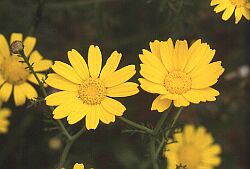
|
Chrysanthemum
coronarium
The "Crown Daisy" was laid on His Body when He was entombed. It's the
most prominent flower seen in the Shroud, and it blooms between March
and May when the Crucifixion took place. The flower appears in many
Jesus icons (ex. the 6th c. Pantocrator icon at St. Catherine's
Monastery in Egypt and a 7th century solidus coin minted under
Justinian II).
|
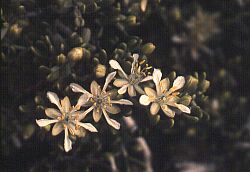 |
Zygophyllum
dumosum
Zygophyllum dumosum leaves and flowers
are visible in the image, too, and its pollen has been found in the
Shroud also. This is the second most prominent flower found in the
Shroud's image.
|
|
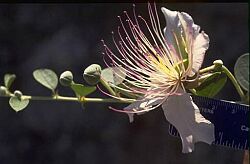
|
Capparis
aegyptia
Flowers of this plant open up between Noon and sunset. The flowers
visible in the Shroud indicate a time of around 4PM.
|
|
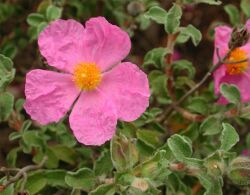
|
Cistus
creticus
Many pollen grains of this lovely flower, also known as "Rock Rose,"
have been found on the Shroud, which support the identification of an
unclear image of what appears to be this flower on the Shroud.
|
|
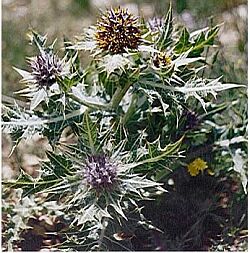
|
Gundelia
tournefortii
Gundelia tournefortii pollen is
found in abundance on the Holy Shroud. It is believed by some experts
to be one of the plants that, when dried, made up the crown of
thorns.
|

|
Sarcopeterium
spinosa
This plant, too, is thought to make up the crown of thorns. |
|

